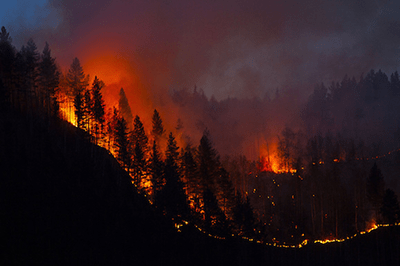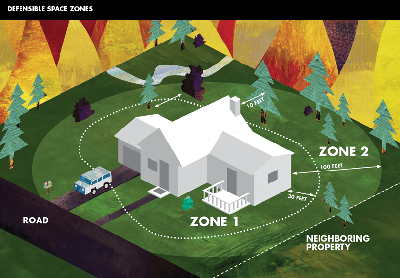About wildfires

Fires have been scorching California since the beginning of time. However, the California fire season since 2017 has intensified in strength, duration, and size, setting records year after year. Urban sprawl into the Wildland-Urban Interface (WUI)—where the natural land meets human settlement—has increased fire risk for communities and the natural environment. California's high housing costs have caused more households to move into the WUI in what's known as "Fire Severity Zones" to find affordable housing. Many of these homes are not ready for wildfires.
To view fire risk zones across the state, view the map from Cal Fire. As fire risk expands across California, Cal Fire updates these maps to reflect risk.
California's communities can and must learn to live with fire risk and manage it effectively through housing design, construction, and ongoing infrastructure, land sites, and housing operations. Wildfire has always been part of the California ecosystem. Native Americans used fire as a tool to care for the land and prevent wildfires, a practice called cultural burning or controlled burning. For the last century, fire suppression became the leading mitigation approach, creating more risk and volatility in wildfire incidents. In addition, underfunded land management, use of non-native plants, reduction in fire-resistant forests, and poor water management became common practices, contributing to the devastating wildfires today. Finally, greenhouse gas emissions and climate change have led to a hotter, dryer west, dramatically exacerbating an already hazardous wildfire landscape.
Impacts on Frontline Communities
Wildfires have severe impacts on frontline communities. People with low incomes are more likely to lose their homes and to struggle to recover. People who are undocumented receive little support to prepare or recover. Evacuation is harder for people who do not speak English, people with disabilities, people with low incomes, and seniors. Planned power shutoffs are common occurrences as an attempt to limit fire ignition on risky days. However, losing electricity for hours or days is devastating for people with certain medical conditions and families on fixed incomes that cannot spare to lose food.
Actions to take
For individuals and households
- Determine if you live in a fire-prone area (although everyone in California should prepare for wildfires). To view these zones across the state, view the map from Cal Fire. These maps are outdated and do not fully reflect current conditions, but Cal Fire is updating them. You can expect more significant areas of fire risk. The California Office of Emergency Services has a map of the entire state that shows which hazards are common in your area.
- Sign up for emergency alerts based on your location.
- Review your Insurance Policy and determine if it protects you from fire risk. If you are a renter, ensure you have a renters insurance policy that covers your possessions and can provide you with alternative housing in case of evacuation. Read more about insurance in this piece.
- If you live in a fire-prone area, hardening your home and planning for a wildfire is vital:
- From Cal Fire, here are low-cost and no-cost ways to harden homes and protect them against wildfires.
- For individuals and households (and community-based organizations) looking to be ready for wildfire season, Listos California has guidance in multiple languages.
For community-based organizations and affordable housing providers

- Mitigate fire risk to your properties so that you can continue to serve your communities:
- Create defensible space, a buffer you create between a building on your property and the grass, trees, shrubs, or any wildland area surrounding it. This space is needed to slow or stop the spread of wildfire, and it helps protect your home from catching fire. Good defensible space also provides firefighters a safe area to work in to defend your building. Check out Defensible Space - Ready for Wildfire for more information.
- Harden the property, which means making it more fire-resistant. Check out Hardening Your Home - Ready for Wildfire for more information.
- Choose plants and landscaping that create fire-resistant zones with non-flammable materials such as stone. Check out Fire-Smart Landscaping for more information on what plants and materials to use.
- Look for funding from the California Office of Emergency Services Home Hardening Program, which intends to serve low- and moderate-income groups.
- Get involved in local planning processes. Seek out opportunities to influence the Hazard Mitigation Plan and General Plan, which will guide your local government on planning for future wildfires. Learn about these planning processes from the Association of Bay Area Governments.
- Work with your community to create a Wildfire Response Plan. Here's a great example from Home Forward, an affordable housing provider in Oregon. Reach out to your local Office of Emergency Services for support in creating the plan.
- Use the Enterprise Ready to Respond Toolkit to create a Business Continuity Plan for your residents, buildings, and operations.
- Invest in backup power and alternative energy sources to serve your community's needs during a power shutoff. Create a plan for power shutoffs.
- Apply for CalHome Disaster Assistance, which serves disaster survivor households up to 120 percent of Area Median Income. CalHome can fund pre-development, site development, and site acquisition for development projects, rehabilitation and acquisition and rehabilitation of site-built housing, restoration, repair, and replacement of manufactured homes, down payment assistance, mortgage financing, homebuyer counseling, and technical assistance.
- Use this legislative tracker to read about disaster and climate change bills and call your representatives about them.
For local and State government
- There has been some recent work with Tribes on forest management in California. Continue to allow Native American Tribes to perform their traditional fire management practices. Listen to their recommendations on how to reduce barriers to cultural burning. Here are recommendations from the Karuk Tribe.
- Ensure that all fire warnings are available in all languages spoken in your locale. Use demographic data from the Census and community-based organizations to learn what languages you need to have covered.
- Work with frontline communities to create locations they can go during a power shutoff.
- Do everything you can to support affordable higher density growth in infill locations that have less wildfire risk. Ensure infill development for those that most need affordable housing. Keep in mind other non-wildfire risks as well when considering where to develop new housing.
- Create defensible space requirements and offer support to make it achievable for low-income households. Use Community Emergency Response Teams or other volunteers to help meet the needs of frontline communities.
- Apply for CalHome Disaster Assistance.
- If your locality has received a Fire Management Assistance Grant from FEMA, apply for the Hazard Mitigation Grant Program Post Fire.
- Develop and enforce strict protections for tenants that will be applied before, during, and after a wildfire.
- Create local and regional community preference policies that give residents displaced by disasters a greater chance of returning. The City of Santa Monica has one for its affordable housing units.
- Engage in pre-disaster recovery planning to figure out the best way to manage a wildfire disaster recovery process.
- Create more funding programs for defensible space, home hardening, and fire-resistant landscaping specifically for frontline communities, including those living in manufactured home communities. Make it as easy as possible to get and use the funding.
- Create more job training programs for wildfire mitigation and response, like the Central Valley Forestry Corps.
For philanthropy
- Support wildfire mitigation: creating defensible space, home hardening, and fire resistance landscaping can be very expensive. State and local government is giving funding for this work, but it's never enough. Develop a fund for this crucial work that will go to frontline communities and minimize application requirements.
- Look for opportunities to support the government’s disaster mitigation work with frontline communities by offering to help fund engagement, outreach, and data collection. Better outreach upfront can ensure that programs, plans, and policies serve frontline communities better before, during, and after a wildfire.
- Advocate for and fund initiatives that create more affordable housing in high-density areas less impacted by wildfires.
- Create a pre disaster recovery funding strategy that includes working with community-based organizations, affordable housing developers, and local government to create post-disaster temporary-to-permanent housing for frontline communities. RAPIDO is a great example of this type of housing.
- Give to Native organizing efforts and movements to regain stewardship of the land.
- Advocate for more job training programs for currently and formerly incarcerated people to be in forest management. Here's an example program: The Forestry and Fire Recruitment Program.
- Invest in strategies that reduce greenhouse gas emissions, including solar power and public transportation. Community gardens are a great way to do this and provide food for people during power shutoffs.
- Support social programs that the government doesn't always reach:
- Mutual aid programs that get people necessary items quickly.
- Organizations that support people who are undocumented and immigrants.
- Transportation support for people who are constantly needing to evacuate and travel away from home.
- Intimate partner violence increases exponentially during disasters [vice.com]. Look for ways to fund domestic violence prevention and mental health services post disaster.
Image source: Cal Fire Ready Wildfire
- Training